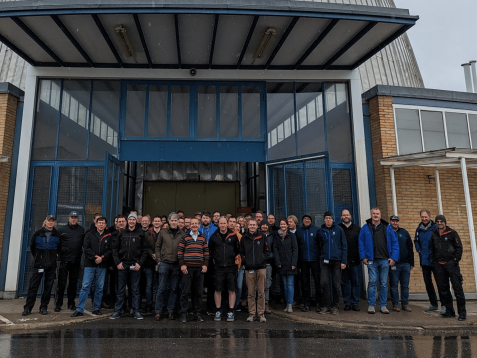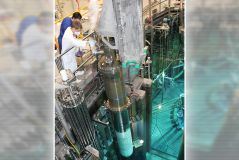MLZ is a cooperation between:
 > Technische Universität München
> Technische Universität München > Helmholtz-Zentrum Hereon
> Helmholtz-Zentrum Hereon
 > Forschungszentrum Jülich
> Forschungszentrum Jülich
MLZ is a member of:
 > LENS
> LENS > ERF-AISBL
> ERF-AISBL
MLZ on social media:

MLZ (eng)
Lichtenbergstr.1
85748 Garching
18.04.2023
FRM II not affected by end of nuclear energy
On April 15, the commercial use of nuclear power for electricity generation in Germany ended in accordance with the Atomic Energy Act. This decision does not affect the Research Neutron Source Heinz Maier-Leibnitz (FRM II).

FRM II employees in front of the FRM (old), also known as the "atomic egg". There, in 1957, the nuclear age had begun in Germany. It is currently being decommissioned. Thus, on the site of FRM II, the first German nuclear reactor and the last operating German reactor with power above 1 MW can be found in the direct vicinity.
FRM II is also currently not in power operation. After a micro leakage in the so-called central channel, the production of this spare part is still ongoing. “The procurement of a highly complex single piece of the highest nuclear requirements requires special care and is carried out under intensive review of the expert appointed by the nuclear regulatory authority,” says the Technical Director of FRM II, Dr. Axel Pichlmaier.
Neutrons for experiments and cancer treatment are missing
At present, therefore, FRM II cannot provide neutrons for experiments to scientific users. Important questions on socially relevant topics ranging from basic physical research, life sciences, engineering sciences, to materials research and energy topics, which can only be answered with neutrons, must therefore still wait to be solved. Important radioisotopes for cancer therapy are not produced and particularly homogeneously doped silicon, indispensable for the transition to renewable energy, is also only produced outside Germany. “The end of this dry spell is foreseeable, however: There will be scientific operation at FRM II again in 2024,” says Pichlmaier.
Downtime means a lot of work
Meanwhile, the downtime is anything but “quiet.” Scientists at the Heinz Maier-Leibnitz Zentrum are modernizing their scientific instruments and making them fit for the next decade in the so-called MORIS program. The neutron source, the FRM II, is being cherished even when it is at a standstill. “Especially during the now enforced long maintenance break, our employees perform almost 2,000 recurring checks on all systems to prove their specification-compliant condition at all times,” Pichlmaier explains. “In addition, they are technically updated. So we are now using this downtime to minimize breaks in the future. We are proud to work at this globally outstanding plant.”
Since April 16, FRM II has not only been Germany’s reactor with the highest neutron flux. It is also the most powerful reactor with permission to operate at power. And Pichlmaier assures, “We’re working toward that and look forward to putting it back into service for science soon.”
MLZ is a cooperation between:
 > Technische Universität München
> Technische Universität München > Helmholtz-Zentrum Hereon
> Helmholtz-Zentrum Hereon
 > Forschungszentrum Jülich
> Forschungszentrum Jülich
MLZ is a member of:
 > LENS
> LENS > ERF-AISBL
> ERF-AISBL
MLZ on social media:



